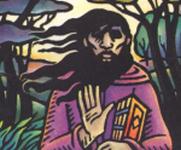The Brother Cadfael mysteries of Ellis Peters are benign fun, but The Hermit of Eyton Forest disappoints a little because of the nearly complete absence of the title character, who turns out not to be what he is supposed. The hermit Cuthred appears suddenly as a pious pilgrim of few words. He follows Rotha Mary Clay’s textbook, mixed with a little eighteenth-century ornamental eremitism, occupying a hermitage on estate grounds, soon consulted by the whole countryside. His cottage has inner and outer rooms, the former including his bed, the latter an altar with candles and missal, before which he spends many hours. In true hermit fashion, Cuthred takes on an errant youth to run errands. And the populace attributes the halting of a cattle murrain to his prayers. Modesty is balanced by fame, the latter “went about by neighbourly whispers, like a prized secret to be exulted in private but hidden from the world.” For all that, the hermit is seldom featured, invisible throughout the mystery until the story’s climax. But at least Peters gives us a stock medieval prop, complete with the roguish ambiguities suggested by medieval history and lore.
He follows Rotha Mary Clay’s textbook, mixed with a little eighteenth-century ornamental eremitism, occupying a hermitage on estate grounds, soon consulted by the whole countryside. His cottage has inner and outer rooms, the former including his bed, the latter an altar with candles and missal, before which he spends many hours. In true hermit fashion, Cuthred takes on an errant youth to run errands. And the populace attributes the halting of a cattle murrain to his prayers. Modesty is balanced by fame, the latter “went about by neighbourly whispers, like a prized secret to be exulted in private but hidden from the world.” For all that, the hermit is seldom featured, invisible throughout the mystery until the story’s climax. But at least Peters gives us a stock medieval prop, complete with the roguish ambiguities suggested by medieval history and lore.